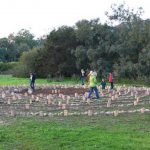
•| The Sharing the Gardens blog supports an on-going conversations between Pacifica’s master land manager Marshall Chrostowski and alumni who enjoy the beauty and intention found in Pacifica’s spectacular campus grounds. |•
The Tree of Memory
Notes on the Hillman Memorial Oak Ceremony | Marshall Chrostowski & Michael Meade
| originally posted on 4 April 2012
•|•|•|•
The Hillman Memorial Oak and Oak Grove
The California Coastal Live Oak was chosen to memorialize James Hillman because, in part, of his focus on the acorn as epitomizing our beginnings, our character and even our fates. The live oak also was valued by the Chumash for its acorns as food and for spiritual qualities, and was known to have been managed by the Chumash to enhance production and health of the trees. The oak tree and grove planted on a low rise (Hillman’s Hillock) will one day inspire future students and visitor to reflect on these matters.
I chose this particular oak with several criteria in mind: a healthy specimen, natural youthful bushiness, a good root system not over-rooted, and sourced from the same watershed as our mature oak trees. To form the future grove, I also planted a seedling started by me from acorns collected on the Lambert Campus. Five other acorns were planted nearby as well, expressing the range of “oak-ness,” so to speak.
After the weekend ceremony we scattered or planted mixed native flower seeds and potted poppies in memory of Hillman and in memory of the Institute’s 30th anniversary, at the end of which participants sowed wild flower seeds nearby. At the same time, I interred a dozen or so additional pouches left there by students and others unable to attend the Hillman Memorial.
In the future a cut-stone sitting wall will bound the Hillman Oak and an appropriate plaque will be installed. Additional landscaping with native plants and medicinal herbs are planned nearby.
The Hillman Oak Grove, then, is comprised of locally sourced acorns, most of which came from the Lambert Campus, and represents the ethos and vision of James Hillman, a lover of gardens.
The Pouch
The memorial weekend culminated in the dedication of the Hillman Oak and ceremonial planting by Steve Aizenstat and Maren Hansen, and others followed with handfuls of soil. Participants of the tree dedication placed their special pouches, now imbued and empowered with prayer and their personal energy and moisture, in a shallow trench encircling the Hillman Oak. In time the roots of the oak will join these life-affirming gifts linking to the Chumash, to the Lambert Campus, and to the world at large.
Think of the pouch as composed of amulets, each significant to Hillman or to our relations to place and time, and looking toward a future framed by the Hillman Oak Grove.
The shell, a small Pismo clam, was retrieved from the old Chumash Hi’Lo village located in the lagoon and slough now mostly filled in and occupied by the Santa Barbara Airport in Goleta. The same shells are found many miles inland under live oak trees, carried there seasonally by the Chumash for their annual acorn harvest (September and October). The shells added calcium and lowered soil acidity and so protected oak roots from fungus. Thus, I chose the midden shell for its connection to millennia of Chumash occupation of the landscape and the ecological intelligence of Chumash practices.
To the pouch I added a few ounces of compost made at the Lambert Campus from yard, farm, and kitchen waste, recycled through the composting processes and representing the land and history of the Lambert site. Nearly all the living plants represented in the compost sample were introduced by Pacifica’s efforts. My intention, then, was to “inoculate” the land and spirit of Ladera with the Lambert compost’s rich microbiological and mineralogical composition.
The final component is a product called AZOMITE®, mined in Utah from layers of volcanic ash mixed in with 70 elements deposited by hundreds of rivers emptying into the shallow inland seas as far back as 30 million years ago. To me, this material represents contributions from the world of geological processes long ago and used today to re-mineralize our depleted agricultural soils.





